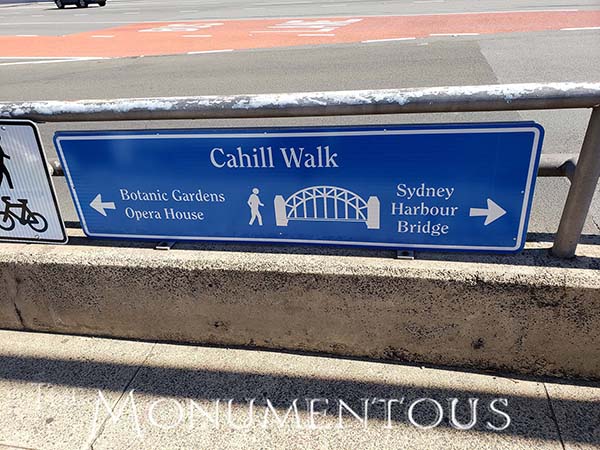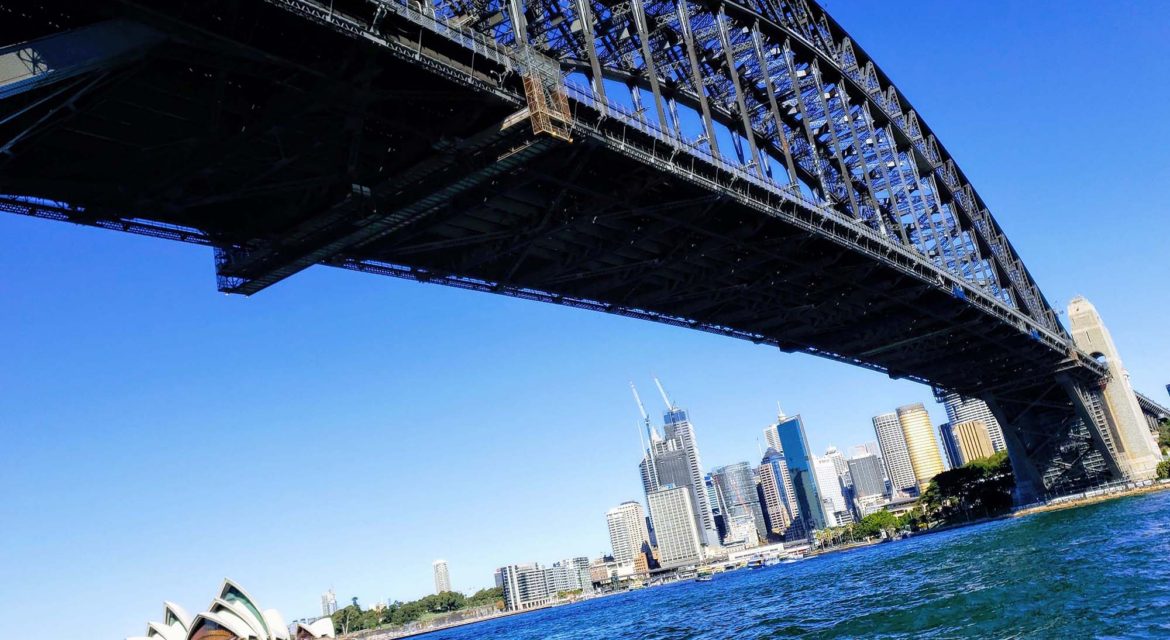 The Sydney Harbour Bridge carries rail, vehicular, bicycle, and pedestrian traffic between the Sydney central business district (CBD) and the North Shore, but the bridge has come to represent something more than a means of travel to the city and for the country. Nicknamed “the Coathanger” by locals because of its arch-shaped design, the bridge has become one of Australia’s most well known and photographed landmarks.
The Sydney Harbour Bridge carries rail, vehicular, bicycle, and pedestrian traffic between the Sydney central business district (CBD) and the North Shore, but the bridge has come to represent something more than a means of travel to the city and for the country. Nicknamed “the Coathanger” by locals because of its arch-shaped design, the bridge has become one of Australia’s most well known and photographed landmarks.
As one of the world’s widest long-span bridges, the Sydney Harbour Bridge has a practical purpose that is a priority above all else. However, the experiences that have been enabled on and around the bridge have allowed it to become an icon for the city which attracts residents from all over the region and visitors from across the world.

Linking the City in More Ways Than One
Plans for a bridge over Sydney Harbour go back to 1912, but it was not until 1922 that funding for the project became available. An arch bridge was chosen because it was less expensive than a cantilever design and capable of handling heavier loads. Opened in 1932 after six years of construction, the arch of the bridge spans 503 meters while the top is 134 meters above the water.
The Sydney Harbour Bridge carries eight vehicle lanes, two train lines, a path for pedestrians and a cycleway. The eastern side of the bridge is where pedestrians can walk from one end to the other, but they can also access the Pylon Lookout, where viewers can get an incredible look across the harbor and bridge. On the way up to the top of the pylon there are 3 levels of exhibits showcasing the history and construction of the Sydney Harbour Bridge.
 The connections the Sydney Harbour Bridge provides aren’t just about the CBD and North Shore though, as the Sydney Harbour Bridge Walk allows visitors to see and experience many different facts of the city. The Sydney Harbour Bridge Walk is part of the Cahill Walk. This 1.3 mile walk links the Royal Botanic Gardens to the features in the North Shore, and there are a variety of features and history for visitors to take in along the way.
The connections the Sydney Harbour Bridge provides aren’t just about the CBD and North Shore though, as the Sydney Harbour Bridge Walk allows visitors to see and experience many different facts of the city. The Sydney Harbour Bridge Walk is part of the Cahill Walk. This 1.3 mile walk links the Royal Botanic Gardens to the features in the North Shore, and there are a variety of features and history for visitors to take in along the way.
Just like the Golden Gate Bridge, visitors can walk across the Sydney Harbour Bridge, and there are many different things to see and experience on each side. On the south end in the CBD, visitors look across the Circular Quay. On the north end of the bridge is Milsons Point and Bradfield Park, both of which provide visitors with a place to relax, read about the history of the area, and enjoy the views of the Sydney Opera House and bridge. Additionally, Luna Park is a short walk from Milson’s Point.
By creating so many active and passive experiences that visitors can engage with in whatever way they want, the Sydney Harbour Bridge has linked the city together in a profound manner. That impact can be seen in everything from the way in which the history of the area is displayed to the bridge hosting one of Sydney’s oldest and most popular Markets.

Connecting the Culture of Sydney
Taking place underneath and in the shadow of the Sydney Harbour Bridge, the Kirribilli Markets were first held in 1976. Today, the market features over 220 stalls selling, new and recycled fashion and accessories, arts and crafts, gourmet foods and much more. Much of the market is located under the structure of the bridge itself which has allowed it to become a literal part of the culture of the city.
 The displays of history that are spread across the Sydney Harbour Bridge Walk and Cahill Walk allow residents and visitors to get a better context of another part of this culture. Whether it’s information about the history of the bridge itself or nearby Bradfield Park or the original inhabitants of the area, visitors can connect with the city in an especially powerful way. Additionally, recreational areas in Milson’s Point along with artwork spread across the entire area provide an entirely different context of the area.
The displays of history that are spread across the Sydney Harbour Bridge Walk and Cahill Walk allow residents and visitors to get a better context of another part of this culture. Whether it’s information about the history of the bridge itself or nearby Bradfield Park or the original inhabitants of the area, visitors can connect with the city in an especially powerful way. Additionally, recreational areas in Milson’s Point along with artwork spread across the entire area provide an entirely different context of the area.
The Harbour Bridge has also become a central element in one of the biggest events in the city. The annual Vivid Sydney festival sees many of the city’s landmarks lit up in rainbow hues, but the way in which the Harbour Bridge is lit is particularly noteworthy. Harbour Lights turns the waters of Sydney Harbour into a light spectacular, with many vessels moving across the water in a gentle, synchronized lighting display.
The cultural impact of the bridge can also be seen in terms of how it is represented in maps and guides of the city. Additionally, there are a countless items for sale which directly incorporate the Sydney Harbour Bridge. These examples showcase how deeply it has been ingrained into the culture of the city whole also also illustrating the powerful economic impact that the bridge has come to enable.

The Economic Impact of a Sydney Icon
The direct and indirect economic impact of the Sydney Harbour Bridge had proven to be substantial, and that impact can be quantified in numerous ways. Sydney received 10.67 million domestic visitors and 4.05 million international visitors in the year ending September 2018. Given the Sydney Harbour Bridge’s appearance on so maps and “things to do” lists, it’s clear that the Bridge has had a major impact on these numbers.
In terms of a direct economic impact, Admission to the Pylon Lookout has provided stakeholders with a direct means of revenue. Additionally, future events in the Pylon Lookout Museum can be scheduled as applicable.
 Since 1998, BridgeClimb has made it possible for anyone to legally climb the southern half of the bridge. Tours run throughout the day, from dawn to night, and are only canceled for electrical storms or high wind. Royals and celebrities have all done the climb, with their pictures on display in the gift shop and online. Prices for the excursion depend on the date, but the Climb allows visitors to ascend the inner arch of the Bridge to take in a spectacular vantage point halfway to the top, along with the incredible view up top.
Since 1998, BridgeClimb has made it possible for anyone to legally climb the southern half of the bridge. Tours run throughout the day, from dawn to night, and are only canceled for electrical storms or high wind. Royals and celebrities have all done the climb, with their pictures on display in the gift shop and online. Prices for the excursion depend on the date, but the Climb allows visitors to ascend the inner arch of the Bridge to take in a spectacular vantage point halfway to the top, along with the incredible view up top.
The Vivid Sydney festival has a tremendous economic impact on the city as well, and it’s one that the Harbour Bridge actively enables. Many commercial operators participate in the installation, enabling their passengers to enjoy Vivid Sydney while offering an additional perspective of the stunning light reflections that reflect on the water.
Much like icons that have come to represent entire cities, numerous businesses have incorporated the Sydney Harbour Bridge into their logos and marketing materials. That impact speaks to the economic and cultural impact that the Sydney Harbour Bridge represents but also underscores what it means when a piece of infrastructure turns into an icon for an entire country.

More Than a Bridge
 Views of the bridge and harbour with the nearby Sydney Opera House have become iconic images of Sydney and Australia itself. Unlike other bridges that have not been able to engage visitors in a direct manner, the range of activities and experiences at Sydney Harbour Bridge have helped to make the Sydney Harbour Bridge more than just a bridge. The difference that doing so has made to Sydney and to Australia as a whole can be seen in countless ways across the city, country and world.
Views of the bridge and harbour with the nearby Sydney Opera House have become iconic images of Sydney and Australia itself. Unlike other bridges that have not been able to engage visitors in a direct manner, the range of activities and experiences at Sydney Harbour Bridge have helped to make the Sydney Harbour Bridge more than just a bridge. The difference that doing so has made to Sydney and to Australia as a whole can be seen in countless ways across the city, country and world.
While the literal impact the bridge has has had is easy enough to recognize, it’s the underlying economic and cultural impact that have proven to be so monumentous for the present and future of the city and country.

